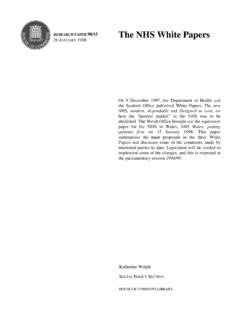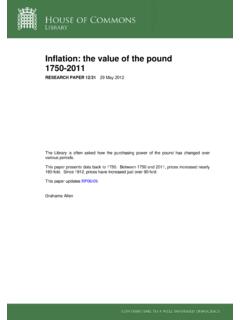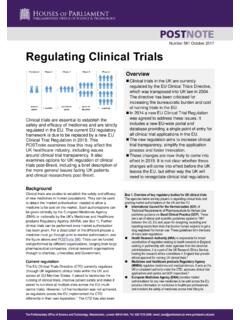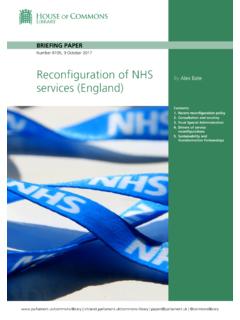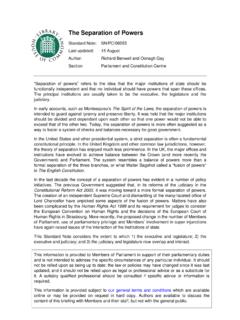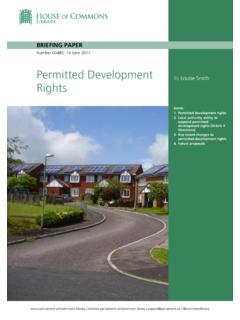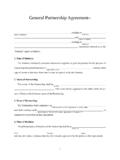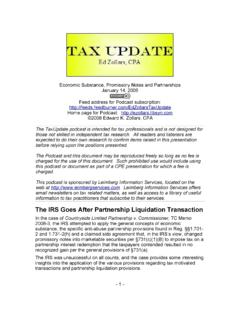Transcription of EU-Japan Economic Partnership Agreement
1 BRIEFING PAPER. Number 8340, 15 June 2018. EU-Japan Economic By Dominic Webb, Ilze Jozepa Partnership Agreement Contents: 1. Introduction 2. What is in the Agreement ? 3. Ratification 4. Continuity of trade agreements after Brexit 5. Parliamentary scrutiny of trade agreements 6. Sources of further information | | | @commonslibrary 2 EU-Japan Economic Partnership Agreement Contents Summary 3. 1. Introduction 4. Background 4. Timeline 4. Why is this debate taking place? 5. Statistics on UK-Japan trade 5. 2. What is in the Agreement ? 6. Removal of tariffs and other obstacles to trade 6. Non-tariff barriers 6. Goods 7. Agriculture 7. Automotive industry 7. Services 8. Opening up public procurement market 8. Small businesses 8. Sustainable development 9. Data protection 9. Investment protection 9. 3. Ratification 10. Mixed vs EU only agreements 10. The European Commission's new approach to trade agreements 10.
2 4. Continuity of trade agreements after Brexit 12. During the transition/implementation period 12. After the transition period 13. 5. Parliamentary scrutiny of trade agreements 14. 6. Sources of further information 16. Cover page image copyright Attributed to: Fly me to the moon by Ruth Hartnup. Licensed under CC BY. cropped 3 Commons Library Briefing, 15 June 2018. Summary This note has been prepared in advance of the debate in the House of Commons on the EU-Japan Economic Partnership Agreement (EPA) on Tuesday 26 June 2018. 1. The EU-Japan EPA is described by the European Commission as the largest bilateral trade deal it has negotiated. Negotiations started in 2013, Agreement in principle was reached in 2016 and the Agreement finalised in 2017. The Agreement is expected to be signed at the EU-Japan summit in July and come into force before the UK leaves the EU.
3 The EPA aims to boost trade between the EU and Japan by reducing tariff and non-tariff barriers. These reductions in trade barriers are estimated to increase UK exports to Japan by between billion and billion. Imports are expected to increase by between billion to billion. The EPA is an EU only Agreement . As such, it does not require ratification by individual EU Member States. The Agreement of the Council of the European Union and the European Parliament is required. The European Scrutiny Committee recommended a debate on the EPA on the floor of the House for the following reasons: The EPA raises complex legal and policy issues for the UK. As, the EPA is an EU only Agreement , this debate provides the only opportunity for the House of Commons as a whole to scrutinise the Agreement before it is signed and concluded It is necessary to understand how the Government will ensure more transparency and scrutiny of trade negotiations.
4 1. The debate had originally been scheduled for 18 June. 4 EU-Japan Economic Partnership Agreement 1. Introduction Background Negotiations for the EU-Japan Economic Partnership Agreement (EPA). started in 2013. Agreement was reached in principle in July 2016 with final Agreement being reached in December 2017. The Agreement is expected to be voted on at the EU General Affairs Council on 26 June and signed at the EU-Japan summit in July. This Agreement is the largest ever bilateral trade Agreement negotiated by the EU. A separate political Agreement , the EU-Japan Strategic Partnership Agreement , was negotiated alongside the EPA. 2. Timeline 2011 The EU and Japan agree to start preparations for a bilateral free trade Agreement (FTA). 2013 EU governments instruct the European Commission to start negotiations with Japan. In the following years, the EU and Japan hold 18.
5 Rounds of negotiations. 6 July 2016 The EU and Japan reach an Agreement in principle on the main elements of the EU-Japan Economic Partnership Agreement (EPA). 8 December 2017 The EU-Japan EPA is finalised. 26 June 2018 The House of Commons debates the EPA3. 26 June 2018 The Council of the EU expected to adopt EPA. July 2018 Signature of Agreement at EU-Japan summit 2019 The EU-Japan EPA comes into effect. The European Commission aims for the Agreement to come into effect before the end of its mandate in 2019, after the approval of the Council of the EU and the European Parliament. However, negotiations with Japan on investment protection standards and investment protection dispute resolution will continue. 4. 2. Details of the Strategic Partnership Agreement are in European Scrutiny Committee, Twenty-ninth Report of 2017-19, 23 May 2018, HC 301-xxviii, p58. 3.
6 The debate had previously been scheduled for 18 June. 4. For more information on the investment protection Agreement see section of this note. 5 Commons Library Briefing, 15 June 2018. Why is this debate taking place? The European Scrutiny Committee recommended that a debate on the Agreement take place on the floor of the House for the following reasons: the EU-Japan EPA raises complex legal and policy issues for the UK, both while it is a Member of the EU and after its withdrawal from the EU, which the Government must address before the Agreement 's expected adoption by the Council on 26 June;. as this is an EU-only trade Agreement (that does not require ratification by individual Member States in accordance with their own domestic procedures), such a debate would provide the only opportunity for the House of Commons as a whole to scrutinise and have a say on the Government's position on the EU-Japan trade Agreement before it is signed and concluded; and the need to understand what steps this Government will take to ensure more transparency in and scrutiny of trade negotiations, both as a member of the EU and after UK.
7 Withdrawal (when it is able to operate an independent trade policy) is fundamental to ensuring the democratic accountability of trade deals that the UK is or intends to become party to 5. Statistics on UK-Japan trade UK exports to Japan totalled billion in 2017, with services accounting for more than half. Imports were billion. The UK. therefore had a surplus of billion. A deficit of billion on trade in goods was outweighed by a surplus of billion on trade in services. In 2016, Japan was the UK's 11th largest export market, accounting for of UK exports of goods and services. 6. UK TRADE WITH JAPAN. billion, 2017. Exports Imports Balance Goods Services + Total + Source: UK Economic Accounts, March 2018, Table B6B. 5. European Scrutiny Committee, Twenty-ninth Report of 2017-19, 23 May 2018, HC. 301-xxviii, para 6. Source: ONS Pink Book 2017, Table , counting EU member states separately.
8 6 EU-Japan Economic Partnership Agreement 2. What is in the Agreement ? Removal of tariffs and other obstacles to trade At entry into force of the EU-Japan EPA, 91% of customs duties paid by EU companies entering the Japanese market will be removed, and the level of liberalisation will rise to 99% at the end of the final liberalisation step. The remaining imports (1%) will be partly liberalised through quotas and tariff reductions (in agriculture). At present, Japanese rules and regulations tend to differ from international standards and practices, resulting in high compliance costs for EU firms who export to Japan. Therefore the EPA will remove a number of regulatory barriers, for example by improving access to the Japanese car market and giving better market access for European agricultural products. The EU. estimates the Agreement will save its exporters 1 billion ( 870 million).
9 In customs duties per year. The Government's Explanatory Memorandum on the EPA said: The [ EU-Japan EPA] will enable UK firms to export and import at a lower cost and give more opportunity for UK businesses to bid for public procurement contracts in Japan. Furthermore, the [EU- Japan EPA] will increase the welfare of UK households by lowering the price of final goods and services and increase consumer choice due to greater competition. [..]. From the UK perspective, priority areas such as agricultural products, processed foods, beer, wine, and whisky exports will enjoy lower tariffs. In the automotive sector, Japan and the EU. agree to follow the United Nations Economic Commission for Europe standards on product safety and the protection of the environment. The deal includes a seven-year staged elimination of EU import tariffs on cars and car parts, a key EU concession in exchange for Japanese concessions on agricultural imports.
10 7. Non-tariff barriers In order to reduce technical barriers to trade, Japan and the EU have agreed to ensure that their standards and technical regulations are based on international standards to the greatest possible extent. Negotiations addressed various non-tariff measures, as some Japanese technical requirements and certification procedures often make it difficult to export European products to Japan. Examples of non-tariff measures, which were successfully addressed, include product safety standards, the protection of the environment for motor vehicles, and textiles labelling. Both sides have also agreed on an international standards based system for quality management of medical devices. In addition, the EPA creates a more predictable regulatory environment for EU agricultural products exported to Japan by addressing sanitary and phytosanitary measures.


